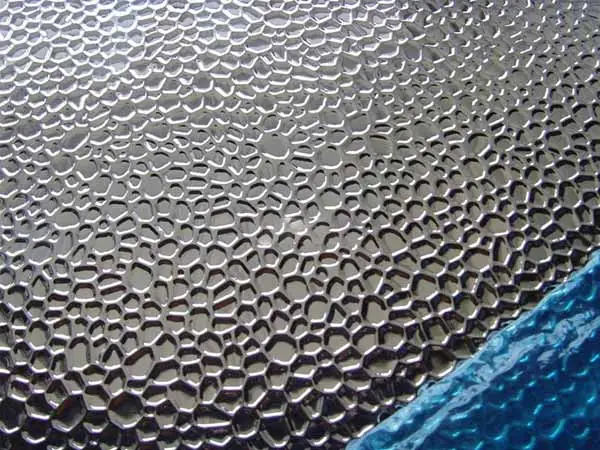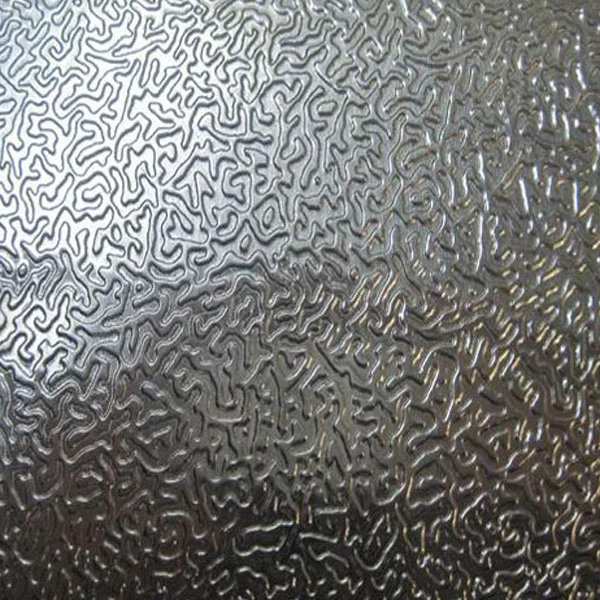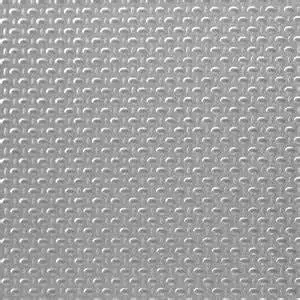Embossed Aluminum Coil Einführung
Embossed aluminum coil refers to a type of aluminum coil that has a textured pattern or design embossed or pressed onto its surface. The embossing process involves using a combination of heat and pressure to create raised or recessed patterns on the aluminum sheet or coil.
Embossed aluminum coils are commonly used in various industries and applications. The embossed patterns not only enhance the aesthetic appeal of the aluminum surface but also provide functional benefits such as improved grip, increased durability, and enhanced resistance to scratching or damage.

Common Embossed Patterns
Stucco Pattern
The stucco pattern is perhaps the most widely used embossed pattern in aluminum coils. It features a raised texture that resembles the rough texture of stucco or plaster. The pattern consists of small, randomly arranged bumps or dots.
Characteristics: The stucco pattern provides excellent anti-slip properties and is commonly used in applications where grip is important, such as flooring, ramps, and staircases. It also helps to hide surface imperfections and provides enhanced strength and durability.

Diamond Pattern
The diamond pattern consists of a series of raised diamonds or lozenges embossed onto the surface of the aluminum coil. The diamonds are typically arranged in a regular, repeating pattern.
Characteristics: The diamond pattern offers excellent structural integrity and rigidity. It provides increased strength and resistance to bending or warping. The pattern is commonly used in applications that require a combination of strength and aesthetic appeal, such as truck beds, toolboxes, and decorative panels.

Hammer Pattern
The hammer pattern features a textured surface that resembles the hammered metal finish. It consists of irregular, raised indentations or dimples distributed across the surface of the aluminum coil.
Characteristics: The hammer pattern provides a unique and visually appealing texture. It offers good anti-slip properties and is commonly used in applications where both functionality and aesthetics are important, such as decorative elements, furniture, and interior design.

Orange Peel Pattern
Die orange peel pattern gets its name from its resemblance to the texture of an orange peel. It consists of small, rounded bumps or dimples evenly distributed across the surface of the aluminum coil.
Characteristics: The orange peel pattern offers good anti-slip properties and provides a decorative and distinctive appearance. It is commonly used in applications such as refrigerator panels, air conditioning units, and decorative trim.

Linen Pattern
The linen pattern features a textured surface that resembles the weave of linen fabric. It consists of fine, parallel lines embossed onto the aluminum coil.
Characteristics: The linen pattern provides a sleek and sophisticated appearance. It is commonly used in architectural applications, interior design, and decorative elements where a refined and elegant texture is desired.

Embossed Aluminum Coil Processing
- Cleaning and Degreasing: Thoroughly clean and degrease the coil surface to remove contaminants that could impact the embossing process.
- Vorheizen: Preheat the aluminum coil to a specific temperature to make it more malleable for embossing.
- Embossing: Pass the preheated coil through embossing rollers or a press to apply pressure and heat, transferring the desired pattern onto the aluminum surface.
- Cooling and Quenching: Rapidly cool the embossed aluminum coil to set the pattern and stabilize the mechanical properties.
- Surface Treatment (Optional): Apply surface treatments such as anodizing, painting, or coating for enhanced corrosion resistance or improved aesthetics.
- Cutting and Slitting: Cut or slit the embossed aluminum coil into the desired widths or lengths to meet specific application requirements.
- Quality Inspection: Conduct a thorough inspection of the embossed aluminum coils to ensure they meet the required standards and specifications.
Embossed Aluminum Coil Application
Embossed aluminum coils find a variety of applications across different industries. Here are some specific applications where embossed aluminum coils are commonly used:
Construction Industry
- Überdachung: Geprägte Aluminium-Coils werden für Dachbleche und -paneele verwendet, die sowohl ästhetisch ansprechend als auch langlebig sind.
- Abstellgleis: Sie werden für die Außenverkleidung von Gebäuden verwendet und verleihen ihnen Textur und visuelles Interesse.
- Dekorative Elemente: Geprägte Aluminiumspulen werden für dekorative Blenden, Verkleidungen und Akzente in der Architektur verwendet.
Transportindustrie
- Fahrzeugtafeln: Geprägte Aluminiumspulen werden für die Herstellung von Karosserieteilen wie Türen, Kotflügeln, Motorhauben und Kofferraumdeckeln verwendet.
- Anhänger: Sie werden für Anhängeraufbauten verwendet, z. B. für Fracht- und Pferdeanhänger sowie für die Außenhaut von Wohnmobilen (RV).
- Beschilderung: Geprägte Aluminiumspulen werden für die Herstellung von Schildern, einschließlich Verkehrsschildern und Werbetafeln, verwendet.
Verpackungsindustrie
- Getränkedosen: Geprägte Aluminiumspulen bilden die Grundlage für die Herstellung von Getränkedosen und bieten Textur- und Branding-Möglichkeiten.
- Lebensmittelverpackungen: Sie werden für Verpackungsanwendungen in der Lebensmittelindustrie verwendet, z. B. für Schalen, Behälter und Deckel.
- Haushaltsgeräte
- Kühlschränke: Für die Außenverkleidung von Kühlschränken werden geprägte Aluminiumspulen verwendet, die eine strukturierte und attraktive Oberfläche ergeben.
- Backöfen und Kochfelder: Sie werden für Paneele und Oberflächen in Küchengeräten verwendet und bieten Haltbarkeit und ein elegantes Aussehen.
Möbel und Innenarchitektur
- Dekorative Paneele: Geprägte Aluminiumspulen finden Anwendung bei der Herstellung von Dekorplatten für Möbel, Wandverkleidungen und Trennwände.
- Verzierungen und Akzente: Sie werden verwendet, um Möbelstücken, Schränken und Einrichtungsgegenständen visuelles Interesse und Textur zu verleihen.
- Industrielle Anwendungen
- Bodenbelag und Treppenstufen: Geprägte Aluminiumspulen mit rutschfesten Mustern, wie Stuck oder Diamant, werden für Industrieböden, Rampen und Stufen verwendet.
- Werkzeugkästen: Sie werden für die Herstellung robuster Werkzeugkästen mit erhöhter Festigkeit und Widerstandsfähigkeit gegen Beschädigungen verwendet.

Zusammenfassung
Zusammenfassend lässt sich sagen, dass geprägte Aluminiumbänder ein vielseitiges und optisch ansprechendes Material sind, das in verschiedenen Branchen eingesetzt wird. Es wird hergestellt, indem der Oberfläche von Aluminiumbändern durch ein Prägeverfahren erhabene oder vertiefte Muster verliehen werden. Die geprägten Muster verbessern nicht nur die Ästhetik des Aluminiums, sondern bieten auch funktionale Eigenschaften wie Griffigkeit, Rutschfestigkeit und Haltbarkeit.

FAQ
Was ist der Unterschied zwischen Aluminiumblech und -band?
Der Unterschied zwischen Aluminiumblechen und -coils besteht darin, dass ein Aluminiumblech ein flaches, rechteckiges Stück Aluminium ist, während ein Aluminiumcoil eine kontinuierliche Rolle aus Aluminiumblech ist, die durch Walzen über eine Reihe von Rollen hergestellt wird.
Was ist Aluminium-Coil-Blech?
Ein Aluminium-Coil-Blech ist ein flaches Blech, das aus einem Aluminium-Coil geschnitten wird und die Vorteile einer flachen Form bietet, während die Vorteile der kontinuierlichen Länge des Coils erhalten bleiben.
Was ist der Unterschied zwischen Gravur und Prägung?
Beim Gravieren wird ein Muster in eine Oberfläche geschnitten oder eingeschnitten, wodurch ein vertieftes Muster entsteht, während beim Prägen erhabene Muster oder Designs auf einer Oberfläche durch Pressen oder Stempeln erzeugt werden, wodurch ein erhabenes Muster oder Design entsteht, das sich von der umgebenden Oberfläche abhebt.


